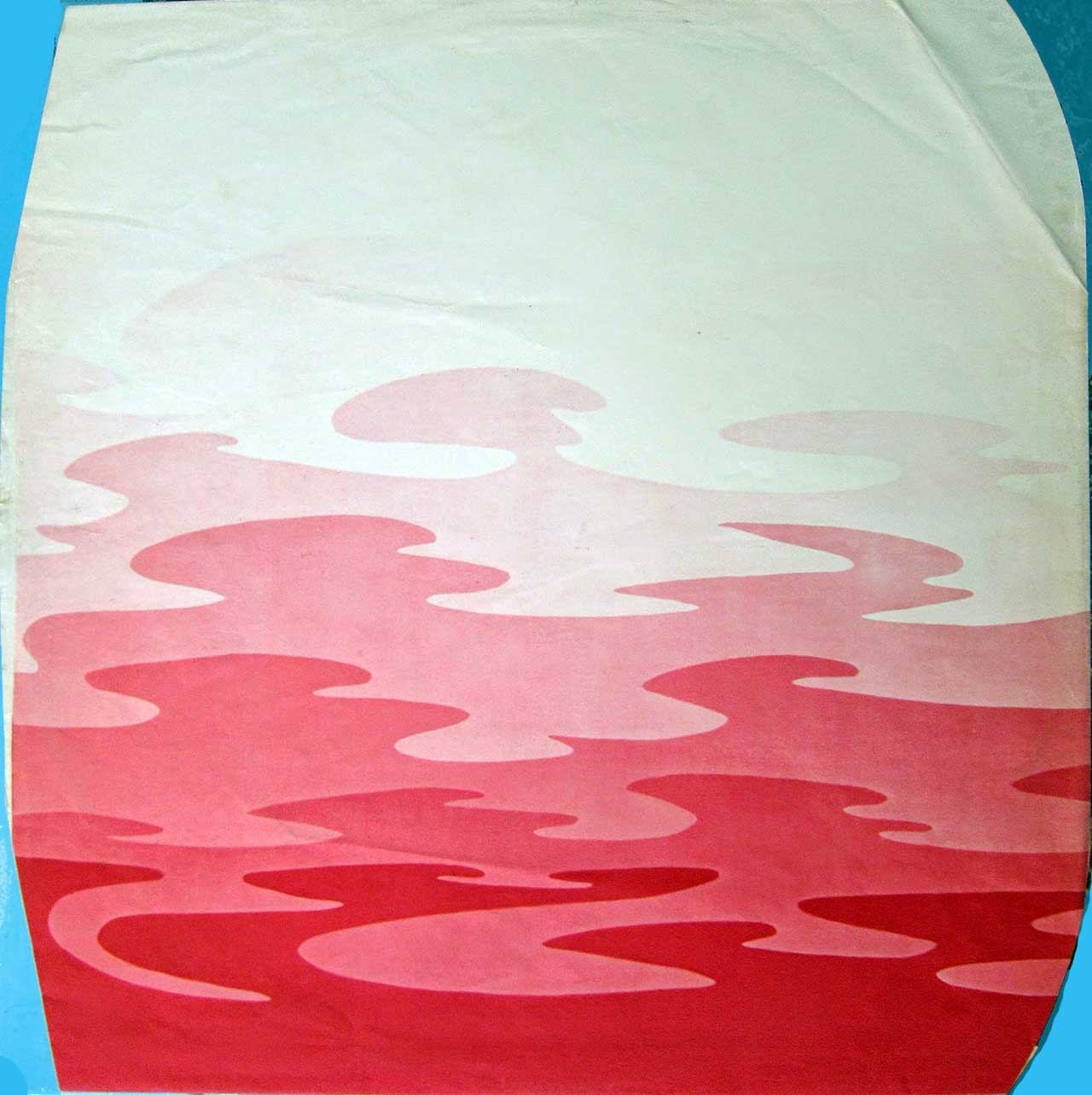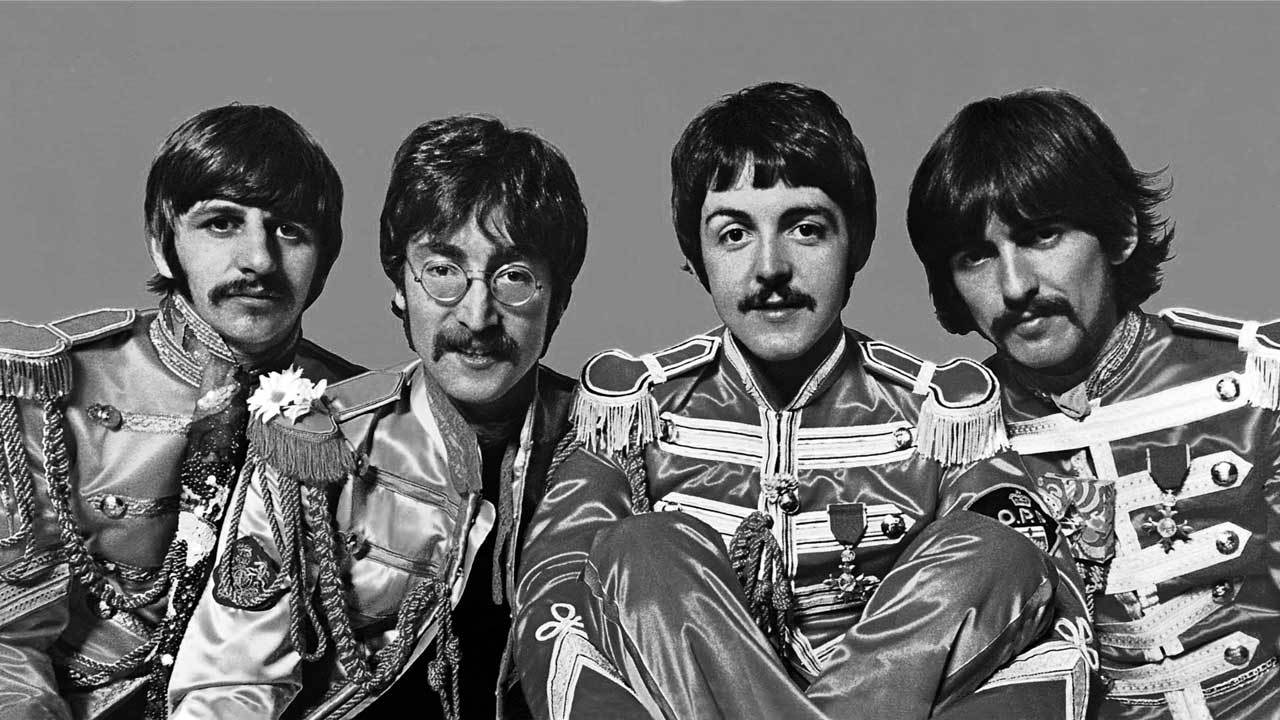Fifty years since its release, perhaps you still don’t know everything about Sgt. Pepper…
50. It all began on a flight back to London in November 1966, as a jaded McCartney dreamt of escaping “all that boy band shit” by reinventing The Beatles as a band of alter egos. By the time the in-flight meal arrived, he’d settled on a suitably “stupid-sounding” bandleader. “They had those little packets marked S and P,” he recalled, “So I said, ‘Sergeant Pepper’, just to vary it. ‘Sergeant Pepper, salt and pepper’, an aural pun, just playing with the words.”
49. The lurid Lonely Hearts Club Band outfits were commissioned from London costumier Berman’s, and later sold off-the-peg at the doomed Apple Boutique. “At the back of our minds, I think the plan was to have garish uniforms which would actually go against the idea of uniform,” said McCartney in the Anthology. “So, for the cover, we wouldn’t just have our Beatle jackets on, or we wouldn’t just be suave guys in turtlenecks looking like we did on Rubber Soul. It would now be much more pantomime, much more Mr Bojangles.”
48. Sessions began in unpromising fashion with the pootling When I’m Sixty-Four, recorded in Abbey Road’s Studio Two on December 6th. In fact, the song had originally been written by McCartney as a teenager, was occasionally pulled out in Cavern Club days, and was now recorded with the bassist’s voice sped up. “I wanted to appear younger,” he reasoned, “but that was just to make it more rooty-tooty.”
47. Throw a stick in Abbey Road Studios in 1967 and you’d have hit a seminal British rock band. Along with The Beatles, Slade and Pink Floyd were also tracking at the studio at the time – with the latter breaking off from Piper At The Gates Of Dawn to watch Lovely Rita being laid down. “They were God-like figures to us,” recalls Nick Mason.
46. Pepper could have been even better. At those first late-1966 sessions, the band laid down stone-cold classics Strawberry Fields Forever and Penny Lane: both earmarked for the album until EMI demanded an appetite-whetting stopgap single. Surrendering the songs, recalled producer George Martin, was “the biggest mistake of my professional life”.
45. The famous sleeve cost an unprecedented £3,000 (compared to the industry-standard £50), but designer Sir Peter Blake received only £200 (plus lifelong kudos). “People say to me, ‘You must have made a lot of money on it’,” he reflects, “but I didn’t because Robert Fraser [art director] signed away the copyright. But it has never mattered too much because it was such a wonderful thing to have done.”
44. Pepper took 700 hours to record, over a period of 129 days. To put that in perspective, 1963’s Please Please Me took just over nine hours.
43. Never the most pitch-perfect Beatle, Ringo refused to sing the original draft of With A Little Help From My Friends (“What would you do if I sang out of tune?/Would you throw ripe tomatoes at me?”), fearing that audiences would take the bait.
42. Lennon’s original handwritten lyric sheets have always been the hottest Pepper memorabilia at auction. In 2010, A Day In The Life went for £810k at Sotheby’s, and the following year, Lucy In The Sky With Diamonds fetched £180k.
41. Mind you, Beatles collectors will buy anything. Even the frankly terrifying Shirley Temple doll went for a cool £13k in 2005.
40. Most of Pepper’s key songs – the title track, Fixing A Hole, Getting Better – were written on McCartney’s ‘magic piano’: a psych-painted instrument, created by Dudley Edwards and Douglas Binder in October 1966, that also inspired the album’s kaleidoscope aesthetic. “That piano,” notes Micky Dolenz of The Monkees, “is the freakiest thing you’ve ever seen.”
39. Not usually counter-culture arbiters, the Daily Mirror and Daily Mail played a vital role in Pepper, providing the headlines that sparked McCartney’s She’s Leaving Home and Lennon’s A Day In The Life. “I was writing the song with The Daily Mail propped up in front of me on the piano,” noted the latter. “I had it open to the ‘news in brief’ or whatever they call it.”
38. Fixing A Hole marked the first time The Beatles ventured outside Abbey Road to use another British studio. Unfortunately, Martin wasn’t impressed by Regent Sound Studios – “A boxy little room” – and the song was completed back on home turf.
37. Jesus was present at the recording of Fixing A Hole (sort of). “A guy arrived at my front gate and said, ‘I’m Jesus Christ’,” recalls McCartney. “I said, ‘I’ve got to go to a session, but if you promise to be very quiet and just sit in a corner, you can come’. So he did, he came to the session and he did sit very quietly and I never saw him after that.”
36. The waxworks representing the band in their Fabs incarnation were on loan from Madame Tussauds. They would subsequently vanish from the London attraction until 2005, when they surfaced at auction and sold for £81,500. “You wouldn’t think,” noted auction house Cooper Owen, “that anyone would be willing to pay this much for some wax.”
35. Getting Better isn’t as chipper as it sounds. Alongside Lennon’s mordant chorus interjections (“It can’t get no worse”), the lyric was an admission of his violent past. “It is a diary form of writing,” he told Playboy in 1980. “All that ‘I used to be cruel to my woman/I beat her and kept her apart from the things that she loved’ was me. I used to be cruel to my woman, and physically – any woman. I was a hitter. I couldn’t express myself and I hit. I fought men and I hit women. That is why I am always on about peace, you see. It is the most violent people who go for love and peace.”
34. The first civilians to hear Pepper – whether they wanted to or not – were the Chelsea neighbours of ‘Mama’ Cass Elliot, when The Beatles blasted the album out of her open windows one Sunday morning in April 1967. “All the windows around us opened and people leaned out, wondering,” remembered Apple Corps boss Neil Aspinall. “It was obvious who was on the record. Nobody complained. People were smiling and giving us the thumbs-up.”
33. For a supposedly untouchable rock‘n’roll benchmark, Pepper reviews have always been decidedly mixed. In 1998, it topped a Melody Maker poll as the ‘worst record ever’, while in 2007, The Guardian declared it the ‘most overrated album of all time’. Back in 1967, the New York Times was just as savage. “It did actually get a terrible review,” says McCartney. “The critic said he hated it, thought it was a terrible mess.”
32. Getting Better did exactly that. The album version was mixed from Take 15.
31. Lennon wanted A Day In The Life to conclude with “a sound building up from nothing to the end of the world”, and Martin simulated the apocalypse by instructing each instrument in the orchestra to start on the lowest note then ascend for 24 bars (at which point Lennon, McCartney, Starr and road manager Mal Evans each played an E chord on four pianos). “You’ve got to make your own way up there, as slidey as possible so that the clarinets slurp, trombones gliss, violins slide without fingering any notes,” Martin told Mark Lewisohn of his instructions. “And whatever you do, don’t listen to the fellow next to you, because I don’t want you to be doing the same thing. Of course they all looked at me as though I was mad.”
30. Although it was hailed for popularising the concept album, The Beatles admitted the Pepper narrative “doesn’t go anywhere”. As Starr notes in the Anthology: “It was going to run like a rock opera… but we only got as far as Sgt. Pepper and Billy Shears and then we thought, ‘Sod it’. It’s just two tracks.”
29. Aside from de facto bandleader McCartney, The Beatles didn’t much enjoy making Pepper. Pining for India, a largely absent Harrison compared the studio production to an “assembly process”, while Lennon spoke of writing songs “to order” and Starr recalled playing chess with the roadies as “the geniuses were putting on harmonies and orchestras”.
28. The received wisdom is that Lennon was responsible for Being For The Benefit Of Mr Kite!, inspired by a 1843 poster for Pablo Fanque’s Circus Royal. In a 2013 interview, McCartney begged to differ: “I read, occasionally, people say, ‘Oh, John wrote that one’. I say, ‘Wait a minute, what was that afternoon I spent with him, then, looking at this poster?’ I was happy to kind of reclaim it as partially mine.”
27. McCartney still struggles with the Mr Kite! bassline. “It’s challenging!” he noted in a 2014 Twitter interview – but also chose it as his favourite.
26. Lennon was largely dismissive of his Pepper contributions. Good Morning Good Morning was “a throwaway, a piece of garbage” while Mr Kite! was “just going through the motions” (although A Day In The Life was “a damn good piece of work”).
25. The EMI sound library’s selection of organ recordings didn’t meet Lennon’s brief for Mr Kite! (“I want to smell the sawdust on the floor”). To create a suitably frazzled effect, Martin and Geoff Emerick compiled all the organ effects onto one tape, which according to the engineer was then “chopped to pieces and stuck together upside down and the wrong way round”.
24. The running order for Side One was originally: Sgt. Pepper, With A Little Help From My Friends, Mr Kite!, Fixing A Hole, Lucy, Getting Better and She’s Leaving Home.
23. The cheer that opens With A Little Help From My Friends was taken from a Beatles concert at the Hollywood Bowl.
22. The kazoo-style parps on Lovely Rita were created by Harrison, Lennon and McCartney blowing through combs wrapped in EMI’s bum-shredding toilet paper. “It was very thin,” says composer and Beatles lecturer Scott Freiman, “because EMI was cheap. They sent Mal Evans to the bathroom to get it.”
21. Pepper’s ambitious soundscapes was recorded using rudimentary four-track equipment – a source of much irritation to Martin, according to Slade’s Don Powell. “The Beatles were in Studio Two and we were in Studio Three,” writes the drummer. “One thing I remember was George Martin walking out of the studio. He went, ‘Arghh!’, burying his face his hands… in those days it was still only four-track studios, so they were bouncing down and overdubbing. It must have been a complete mind game for him.”
20. The original plan was to include a packet of sweets, decals, badges and pencils inside the Pepper sleeve. “But that was stopped,” shrugged Blake, “because it would have caused EMI big marketing problems.”
19. If your dog humps the speakers after A Day In The Life, that’s because Lennon requested a few seconds of a 15KHz frequency only audible to canines. US label Capitol weren’t amused, and struck it from the record.
18. McCartney initiated the cover concept with a series of ink sketches. “I did a lot of drawings of us being presented to the Lord Mayor,” he told Barry Miles, “with lots of dignitaries and lots of friends of ours around, and it was to be us in front of a big northern floral clock, and we were to look like a brass band. That developed to become the Peter Blake cover.”
17. Fairground painter Joe Ephgrave was paid £25 to create the sleeve’s central drum head lettering – though co-designer Jann Haworth was always frustrated that he forgot the apostrophe on Pepper’s (“I wish we could have fixed that”). It didn’t bother the collector who bought the skin for a million dollars at a 2008 Christie’s auction.
16. Music aside, Pepper was a trailblazer on every level. It was the first album to print lyrics on the reverse sleeve, the first to eschew gaps (or ‘banding’) between songs and the first to offer something more than the usual plain inner bag (the first pressing had a psychedelic sleeve designed by Simon Posthuma and Marijke Koger of Dutch art collective The Fool).

15. Not everyone was happy about The Fool’s involvement. The designers were originally in the frame to supply Pepper’s front sleeve, but Fraser despised their proposed painting. “He thought it looked like psychedelic Disneyland,” recalls Haworth. “Which it did.”
14. The reverse sleeve also kicked off the ‘Paul is dead’ conspiracy theory, on the tenuous basis that it pictured McCartney with his back to the camera, next to the words ‘Without You’. “It’s all so bloody stupid,” sighed the bassist.
13. The uncredited musicians who play ethnic instruments on Within You Without You were recruited from London’s Asian Music Circle. “We came along one night,” said Lennon, “and George had about 400 Indian fellas playing. It was a great swinging evening, as they say.”
12. The BBC banned several Pepper songs from the radio, including A Day In The Life (which “promoted a permissive attitude towards drug-taking”) and Mr Kite! (for supposed heroin reference ‘Henry the Horse’). “We didn’t really shove the LP full of pot and drugs,” argued Lennon in 1968.
11. Some objects you might not have noticed on the sleeve: a toy snake, a Marra pipe, a candlestick, a miniature trophy, a garden gnome and Lennon’s portable nine-inch Sony TV.
10. The Beatles might never have played Pepper live, but Jimi Hendrix did, borrowing the title track for his June 4th, 1967, performance at London’s Saville Theatre (with McCartney and Harrison present). “That was like the ultimate compliment,” said Macca. “I put that down as one of the great honours of my career.”
9. Not all cover versions have been so auspicious. While Sesame Street’s With A Help From My Friends and Eddie Izzard’s Mr Kite! were mildly risible, Phish’s cloying A Day In The Life and William Shatner’s drunk-uncle take on Lucy In The Sky With Diamonds made you want to saw off your ears and bury them in the garden.
8. Blake was never satisfied with the retouched backdrop on the sleeve. “The sky, the palm tree, it was not done very sympathetically,” he said. “I was very unhappy with it. The cover was meant to be a happening, an environment, but all that got lost. Retouching killed the idea of it being three-dimensional.”
7. Frank Zappa created an apocalyptic parody of the Pepper sleeve for 1968’s We’re Only In It For The Money, but an impasse between his Verve label and Capitol meant the image ended up in the gatefold. Interviewed in 1988, there was still a sour note in Zappa’s voice: “Sgt. Pepper was okay, but I got the impression from what was going on at the time that they were only in it for the money.”
6. Perhaps the oddest choice to appear on the sleeve was US boxer Sonny Liston. The sometime heavyweight champion had previously said of Starr: “My dog drums better than that guy.”
5. Despite his reputation as a mediocre player, Ringo’s beats on A Day In The Life are beyond most modern drummers. At least, according to Phil Collins. “The drum fills on A Day In The Life are very complex things,” said the former Genesis thumper in 1992. “You could take a great drummer today and say, ‘I want it like that.’ They wouldn’t know what to do.”
- Rejoice! Sgt. Pepper has been re-written to tell the story of Star Wars
- The Beatles - Sgt. Pepper’s...50th Anniversary Edition album review
- The Beatles Quiz: how well do you know Sgt. Pepper's Lonely Hearts Club Band?
- Read Classic Rock, Metal Hammer & Prog for free with TeamRock+
4. Given that everyone owned mono equipment in 1967, perhaps it’s understandable that The Beatles bunked off the stereo mix sessions. “The only real version is the mono version,” engineer Richard Lush told Mark Lewisohn. “The Beatles were there for all the mono mixes. Then, after the album was finished, George Martin, Geoff and I did the stereo in a few days, just the three of us, without a Beatle in sight.”
3. The oddest place you’ll find a nod to the Pepper artwork is Liverpool’s Mersey Ferry, which since 2015 has featured a mind-expanding ‘dazzle’ design by Blake. “It’s a crazy concept,” he said. “They’ve done it so beautifully and it looks fantastic.”
2. Pepper has always caused friction between the Beatles and Stones. In a 1970 Playboy interview, Lennon sneered that Jagger and co were riding their coattails (“On every fuckin’ album and every fuckin’ thing we did, Mick does exactly the same. He imitates us… Satanic Majesties is Pepper”). In 2015, Keef didn’t deny it, but dismissed both records (“Some people think [Pepper] is a genius album, but I think it’s a mishmash of rubbish, kind of like Satanic Majesties – ‘Oh, if you can make a load of shit, so can we’”).
1. From May 25th to June 16th, the album’s anniversary will be celebrated in Liverpool with Sgt. Pepper At 50, featuring 13 events inspired by each track. These range from the Fixing A Hole mural created by Judy Chicago at the Stanley Dock, to Good Morning Good Morning pop-up performances, which will see bleary-eyed Scouse commuters greeted by “a host of kazoo-wielding cultural cockerels”. Book tickets at www.sgtpepperat50.com.

